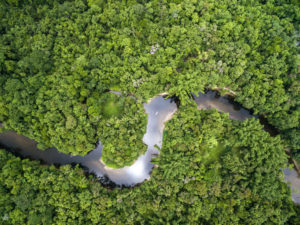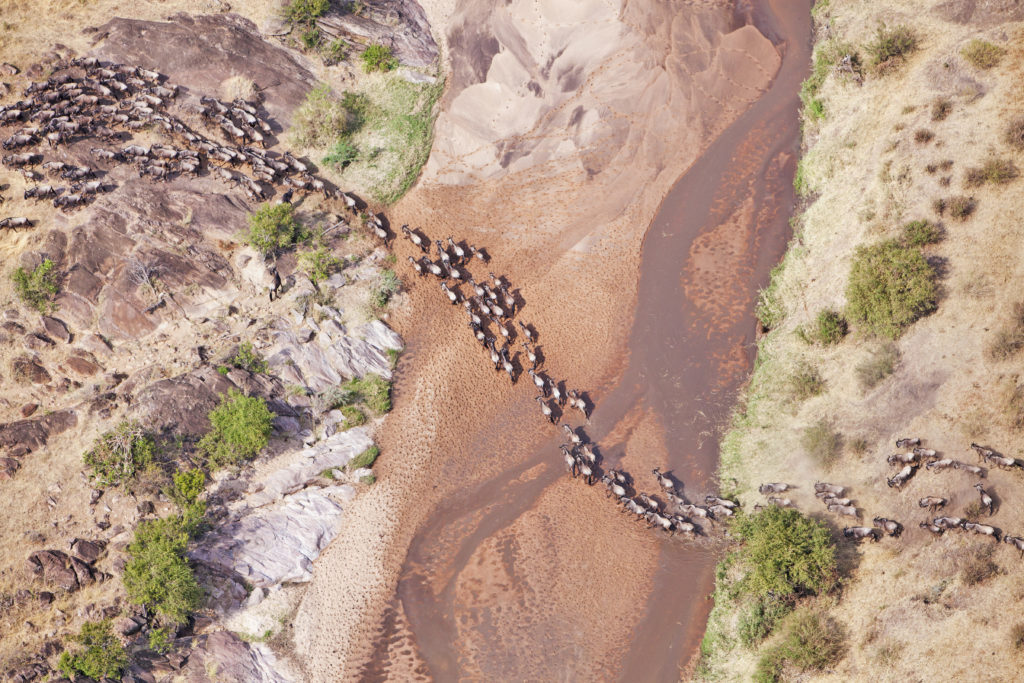Habitat destruction and fragmentation remain the primary threats to biodiversity and as little as 9% of Earth’s terrestrial habitats may at present be adequately connected and protected. A new initiative seeks to conserve, restore and manage ecologically connected networks.
NEWS RELEASE
Center for Large Landscape Conservation, Convention on Migratory Species, IUCN World Commission on Protected Areas’ Connectivity Conservation Specialist Group, WWF
Sharm El-Sheikh, 18 November: WWF, the Center for Large Landscape Conservation and the IUCN World Commission on Protected Areas’ Connectivity Conservation Specialist Group today launched a new initiative to conserve nature’s connections: Wildlife Connect.

The initiative aims to secure ecological connectivity, defined by the Convention on Migratory Species as the “unimpeded movement of species and the flow of natural processes that sustain life on Earth.” From great migrations of wildlife across landscapes and continents to river flows from mountain to sea, nature’s circulatory system of connections is essential for a healthy planet. Yet they are rapidly disappearing, destabilizing ecosystems and the essential benefits they provide for us all.
The Wildlife Connect initiative was launched at the 27th Conference of the Parties to the UN Framework Convention on Climate Change (UNFCCC) [VIDEO below], as connecting lands, inland waters and seas is critical to avert some of the most catastrophic impacts of climate change. Focusing on ecological corridors and networks as nature-based solutions to climate change contributes greatly to climate mitigation and adaptation measures, while providing enormous benefit to nature.
Speaking during the launch event, Amy Fraenkel, the Executive Secretary of the Convention on Migratory Species, said, “Ecological Connectivity is not only vital for migratory species, it also plays a key role in climate change adaptation and ensures the resilience of species and entire ecosystems.”
Governments at the event announced their own efforts to tackle this challenge, such as Canada’s new CAN$60 million program on ecological corridors, Bhutan’s creation of a protected network of corridors across the whole country, and the French government’s new international coalition on biological corridors in Africa.
Experts at the event revealed that as little as 9% of Earth’s terrestrial habitats may at present be adequately connected. That habitat destruction and fragmentation remain the primary threats to biodiversity. And that if unprecedented action is not taken, loss of ecological connectivity will lead to disruption of ecological processes, our ability to adapt to climate change, and may lead to another pandemic.
“The challenge of our time will be building ecologically connected networks of protected and conserved areas that allow wildlife to move to complete their life cycles and adapt to climate change,” said Margaret Kinnaird, Leader Wildlife Practice, WWF International. “And it’s not just about wildlife – ecological connectivity contributes to carbon sequestration by maintaining ecosystem services such as pollination, seed and nutrient dispersal and the clean water on which we all depend. The UNFCCC has a hugely important role to play in ensuring we protect, maintain and restore ecological connectivity as one of many solutions to mitigating and adapting to climate change.”
“Fragmentation is one of the biggest threats to the planet and connectivity conservation links people, places, and species to better harmonize work to save the atmosphere and biosphere,” said Gary Tabor, President and Founder, Center for Large Landscape Conservation (CLLC), and Chair, IUCN WCPA Connectivity Conservation Specialist Group (CCSG). “Connectivity conservation is an available and practical tool that protects biodiversity and the climate.”
“We know what we need to do to halt and reverse biodiversity loss, and deliver a nature positive future. We must protect the natural spaces left on the planet, and restore as much as we can of what we have destroyed. But we also need to ensure the necessary connectivity for wildlife and ecosystems to adapt, particularly in response to climate change impacts which are making habitats unsuitable or increasing competition for resources,” said Marco Lambertini, Director General, WWF International. “It is vital for species to be able to move pole-wards, to higher altitudes, or simply across suitable habitats. Preserving and restoring connectivity between landscapes will be crucial to maintain both ecosystem and biodiversity health, with all the climate, economic and human wellbeing benefits this brings.”
While the ambition of the initiative is global, Wildlife Connect will coalesce around four demonstration landscapes, one each in Africa, Asia, Europe, and Latin America. The landscapes will be laboratories of innovation, where partners will come together to engage, co-create and pilot novel solutions to the most intractable problems that are severing connectivity. The initiative will contribute to bending the curve of biodiversity loss, as well as securing the ecosystem services that we all depend on.
With the launch of the initiative, WWF, CLLC and IUCN WCPA-CCSG are urging world leaders to at least double public finance for adaptation and consider focusing on adaptation in ecological corridors and networks. By taking account of risks and benefits for ecological connectivity, decisions on climate finance and climate action can enhance mitigation and adaptation outcomes through strengthened ecosystem resilience, while maximizing biodiversity co-benefits.
###
Note to Editors:
Governments at the launch event of Wildlife Connect were represented by Inter alia:
- Ronan Dantec, Senator of Loire Atlantique, France & President of Climate Change
- Catherine Stewart, Canada’s Ambassador for Climate Change
- Sonam Dagay, Ministry of Agriculture & Forests, Royal Government of Bhutan
Other recent government commitments on connectivity include:
- The launch by the Tanzanian government of the Wildlife Corridors Assessment, Prioritization and Action Plan to restore, protect and strengthen the conservation of wildlife corridors across the country.
- The US government commitment of US$9.5 million to restore habitat connectivity for aquatic species around the US.
For further information:
- Wildlife Connect website and briefing
- Explainer: Why connectivity matters to people and wildlife
- WWF Manifesto for UNFCCC CoP27
Contact Details:
Marco Lambertini, Director General WWF International and Rafael Antelo, Wildlife Connect Leader are on the ground at Sharm El-Sheikh and available for interviews. Please get in touch with Rafael Antelo (WhatsApp +591 77339633) for more details.
Center for Large Landscape Conservation: Christine Gianas Weinheimer, christine@largelandscapes.org
About WWF
WWF is an independent conservation organization, with over 30 million followers and a global network active in nearly 100 countries. Our mission is to stop the degradation of the planet’s natural environment and to build a future in which people live in harmony with nature, by conserving the world’s biological diversity, ensuring that the use of renewable natural resources is sustainable, and promoting the reduction of pollution and wasteful consumption. Visit panda.org/news for the latest news and media resources; follow us on Twitter @WWF_media
About the Center for Large Landscape Conservation (CLLC)
CLLC protects life on Earth by promoting ecological connectivity to support healthy wildlife habitats and safeguard nature’s resilience to climate change. Learn more at: largelandscapes.org
About the IUCN World Commission on Protected Areas’ Connectivity Conservation Specialist Group (IUCN WCPA-CCSG)
IUCN WCPA–CCSG’s goal is to facilitate global collaboration and action of individuals, communities, and institutions to maintain, enhance, and restore ecological connectivity across intact and fragmented terrestrial, freshwater, and marine ecosystems. Find out more about IUCN WCPA CCSG here.
About the Convention on Migratory Species (CMS)
An environmental treaty of the United Nations, the Convention on the Conservation of Migratory Species of Wild Animals (CMS) provides a global platform for the conservation and sustainable use of migratory animals and their habitats. This unique treaty brings governments and wildlife experts together to address the conservation needs of terrestrial, aquatic, and avian migratory species and their habitats around the world. Since the Convention’s entry into force in 1979, its membership has grown steadily to include 133 Parties from Africa, Central and South America, Asia, Europe and Oceania. Find out more about CMS here: www.cms.int
Photo, top: Aerial view of the Blue Wildebeest (Connochaetes taurinus) migration. Up to 1.5 million wildebeest move through the Mara/Serengeti ecosystem each year. This is one of the world’s last great animal migrations. Masai Mara National Reserve. Kenya. ©Martin Harvey/WWF



